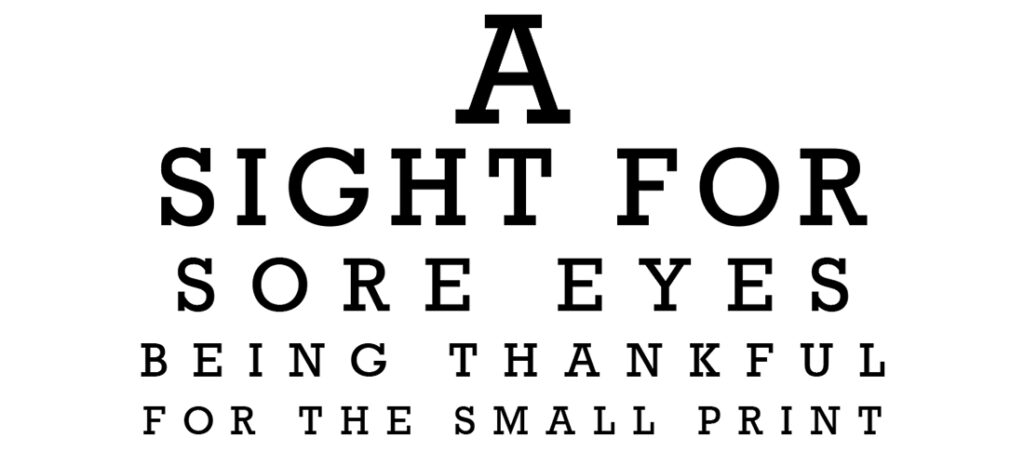Hometown

A Sight for Sore Eyes
Being thankful for the small print
By Bill Fields
I travel some for work, and some of the trips are on planes. Over the last year-and-a-half — as sure as people are determined to wedge steamer trunks into overhead compartments designed for briefcases — you would have seen me closing my left eye and training the right on something. It might be the no-smoking symbol, the lavatory locator, or a chyron on a fellow passenger’s television screen. This is not idle squinting.
I do these in-flight vision tests to reassure myself that my right eye is seeing crisply. Fortunately, it is, which is a reason I’m particularly grateful this Thanksgiving.
In early February 2022, my right eye suddenly wasn’t working properly one morning. It was as if a dark curtain was being pulled up from the bottom. I got to my ophthalmologist’s office by mid-afternoon.
The technician who does the scans is usually cheerful and chatty but didn’t say much this time. In the exam room, looking at the eye chart confirmed why he had been mum minutes earlier.
It wasn’t that the smaller letters were blurry — they were obscured by whatever was going on inside my eye. My vision was limited to the largest letter on top, the “Big E.” I joked about Elvin Hayes, but the young man asking what I could see had no clue about my reference to a basketball star from many years ago.
In the nervous minutes waiting for the doctor to come into the room, I thought about the life of my eyes.
I didn’t even need glasses until I was in college. Covering a Carolina-State football game in Raleigh during the fall of 1979, I realized I was having trouble seeing the jersey numbers. A subsequent exam indicated nearsightedness, and I got glasses for distance.
Contact lenses came later. In my early 40s, like so many others, I began to have trouble seeing up close. I thought about my dad at the breakfast table and how he had held the newspaper increasingly farther away before finally getting a pair of magnifying readers. I recalled my mom saying, “You’re in my light” and not understanding why that was a big deal.
My moment came when I was helping a friend hook up a television on a shelf in an armoire. The back of it was a shadowy tangle of cords, and I had a hard time. I stopped at a drugstore on the way home to purchase reading glasses.
Cataract surgery on both eyes in the fall of 2020 was liberating — I was able after 40 years to ditch corrective lenses for distance. But my vision bliss was short-lived. The ophthalmologist told me I had a detached retina and presently was on the phone to a retina specialist across town. A doctor there confirmed the retina in my right eye was fully detached, and I was headed for surgery the next day.
“You were a 5 out of 10,” the surgeon told me after he had finished. “Not the easiest, not the hardest.”
He had reattached the retina and inserted a gas bubble to encourage healing. The bubble appeared as a dark circle in my vision for more than two months, getting smaller as it dissipated, from the size of a nickel to a speck of black.
For three weeks after the operation, I had to be face-down — “Looking at the Earth,” as the doctor put it — eight to 10 hours per day to maximize the bubble’s effect on the repaired retina. I rented a chair designed for such recoveries. Its mirror allowed me to watch TV, which mitigated the boredom because reading was difficult.
Through months of checkups and eye drops, vision in the surgical eye improved. After the bubble shrank enough to allow some sight, what I had was like looking through a frosted window. Over time, the vision improved and I began to be able to read the smaller lines of type on a poster across my living room couch, my at-home eye chart.
It was 20/120, then 20/80. Earlier this year, an eye test indicated even more improvement: 20/25. Being able to see the little letters is a big deal indeed. PS
Southern Pines native Bill Fields, who writes about golf and other things, moved north in 1986 but hasn’t lost his accent.
